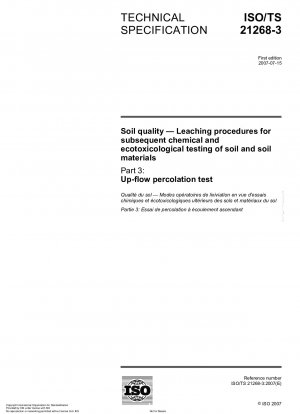ISO/TS 21268-3:2007
Soil quality - Leaching procedures for subsequent chemical and ecotoxicological testing of soil and soil materials - Part 3: Up-flow percolation test
- Standard No.
- ISO/TS 21268-3:2007
- Release Date
- 2007
- Published By
- International Organization for Standardization (ISO)
- Latest
- ISO/TS 21268-3:2007
- Scope
- This part of ISO/TS 21268 specifies a test, which is aimed at determining the leaching behaviour of inorganic and organic constituents from a soil and soil material. The method is a once-through percolation test with water (0,001 mol/l CaCl2) under standardized conditions of flow rate. The material is leached under dynamic hydraulic conditions. The eluates obtained can be used to determine the ecological properties of the soil with respect to micro-organisms, flora and fauna. The test results enable the distinction between different release patterns, for instance wash-out and release under the influence of interaction with the matrix, when approaching local equilibrium between material and leachant. This test method produces eluates, which can subsequently be characterised by physical, chemical and ecotoxicological methods in accordance with existing standard methods. The results of eluate analysis are presented as a function of the liquid/solid ratio. The test is not suitable for species that are volatile under ambient conditions. NOTE 1 Volatile organic constituents include the low-molecular-weight components in mixtures such as mineral oil. NOTE 2 It is not always possible to optimise test conditions simultaneously for inorganic and organic constituents and optimum test conditions may also vary between different groups of organic constituents. Test requirements for organic constituents are generally more stringent than those for inorganic constituents. The test conditions suitable for measuring the release of organic constituents will generally also be applicable to inorganic constituents. NOTE 3 For ecotoxicological testing, eluates representing the release of both inorganic and organic contaminants are needed. In this document, ecotoxicological testing is also meant to include genotoxicological testing. The application of this test method alone is not sufficient for the determination of the leaching behaviour of a material under specified conditions different to those from the test procedure, since this generally requires the application of several test methods, behavioural modelling and model validation. This part of ISO/TS 21268 does not address issues related to health and safety. It only determines the leaching properties as outlined in Clause 4.
ISO/TS 21268-3:2007 Referenced Document
- ISO 10381-1 Soil quality - Sampling - Part 1: Guidance on the design of sampling programmes
- ISO 10381-2 Soil quality - Sampling - Part 2: Guidance on sampling techniques
- ISO 10381-3 Soil quality - Sampling - Part 3: Guidance on safety
- ISO 10381-4 Soil quality - Sampling - Part 4: Guidance on the procedure for investigation of natural, near-natural and cultivated sites
- ISO 10381-5 Soil quality - Sampling - Part 5: Guidance on the procedure for the investigation of urban and industrial sites with regard to soil contamination
- ISO 10381-6 Soil quality - Sampling - Part 6: Guidance on the collection, handling and storage of soil under aerobic conditions for the assessment of microbiological processes, biomass and diversity in the laboratory*, 2009-03-01 Update
- ISO 10523 Water quality - Determination of pH*, 2008-12-01 Update
- ISO 11465 Soil quality; determination of dry matter and water content on a mass basis; gravimetric method; technical corrigendum 1
- ISO 3696 Water for analytical laboratory use; Specification and test methods
- ISO 5667-3 Water quality*, 2024-02-01 Update
- ISO 7027:1999 Water quality - Determination of turbidity
ISO/TS 21268-3:2007 history
- 2007 ISO/TS 21268-3:2007 Soil quality - Leaching procedures for subsequent chemical and ecotoxicological testing of soil and soil materials - Part 3: Up-flow percolation test
